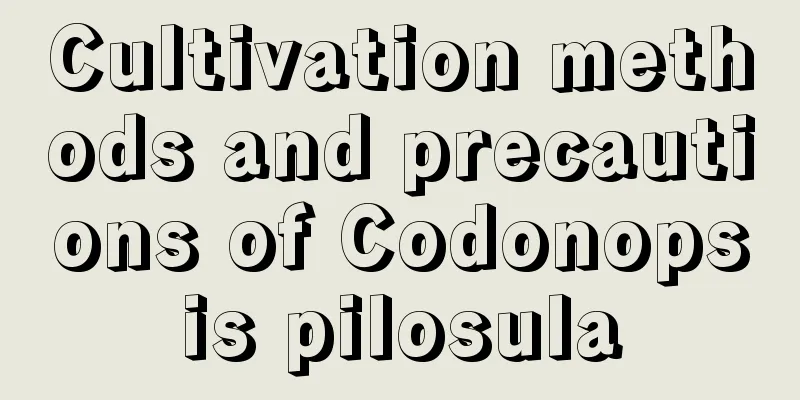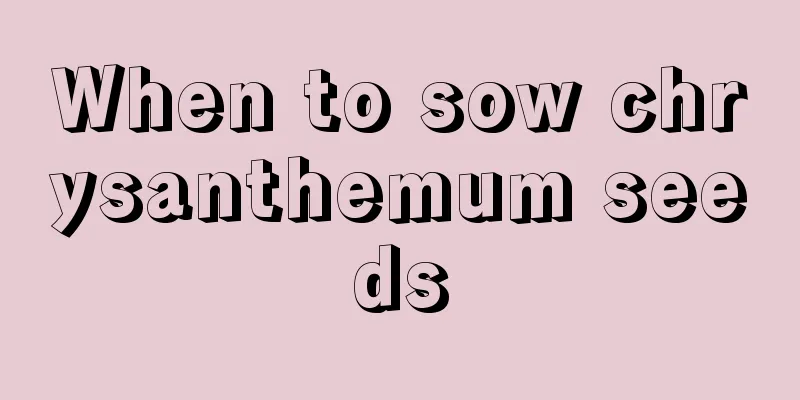Cultivation methods and precautions of Codonopsis pilosula

1. Maintenance methods1. Soil: When planting Codonopsis pilosula, you should choose soil with sufficient nutrients and good drainage. Sandy soil is the most suitable. 2. Water: During the seedling period, spray it with water to make the soil moist. When it grows to five to seven centimeters, it needs to be watered once, but there should be no stagnant water. When there is water accumulation on rainy days, it is necessary to drain it in time. 3. Nutrients: Before planting Codonopsis pilosula, you must first fertilize the soil. Generally, organic fertilizer is used. Spread the organic fertilizer evenly on the soil, and then plow the field. This can better improve the nutrients in the soil. 4. Sunlight: Codonopsis pilosula likes sunlight. Sufficient sunlight is more conducive to its growth. The planting area should face the sun to ensure better growth. 2. Breeding techniques1. Pruning: When the branches and leaves of Codonopsis pilosula grow to about one meter, in order to inhibit its growth, the tips of the branches and leaves need to be pruned. In addition, unhealthy leaves on the plants need to be cut off. 2. Weeding: Some weeds will grow in the soil during maintenance, and they need to be removed in time. Otherwise, the weeds will absorb the nutrients in the soil, and if the nutrients absorbed by Codonopsis pilosula are insufficient, its growth rate will be affected. 3. Problem diagnosis and treatment1. Pests: The main pests are red spiders and mice. Red spiders can be killed by spraying with thiamethoxam, while mice can only be killed with mousetraps or food bait. 2. Root rot: Root rot of Codonopsis pilosula is generally caused by high temperature and waterlogging. At this time, the roots need to be trimmed, and you can also use carbendazim for prevention and control. IV. Other issues1. Build a trellis: When it grows to 30cm, you need to build a trellis to allow it to grow along the way. This can reduce the occurrence of diseases and make the plant more breathable. 2. Transplantation: When transplanting, the damaged roots need to be cut off, and weak seedlings that are not growing well need to be removed to avoid nutrient consumption. |
<<: Cultivation methods and precautions of Da Cangjiaodian
>>: Cultivation methods and precautions of ground dandelion
Recommend
How to raise rainbow jade
1. Watering Generally speaking, it prefers dry po...
How often should lilies be watered?
1. Frequency of water changes When growing lilies...
Common diseases of Clerodendrum thomsoniae and their control methods
Common diseases of Clerodendrum thomsoniae: leaf ...
Who says growing flowers is "expensive"? Pick up these 3 things from the roadside and any flower will grow well with them!
I believe that at this time some people will ask ...
How to care for newly bought periwinkle
1. Soil When growing vinca, you must prepare loos...
The breeding methods and precautions of Chinese giant thorn
Farming methods Repotting For potted Clerodendrum...
What soil is best for potted pomegranates?
Potted pomegranates have strong adaptability and ...
What does ivy do?
Beautiful to watch Ivy is most commonly found on ...
Why did the camellia fall off just after it bloomed?
1. Too many flower buds left Reason: Too many flo...
Pictures of morning glory
Tips for growing honeysuckle The word "茑萝&qu...
Reasons for the shrinkage of the money tree trunk
1. Excessive watering The shrinkage of the money ...
How to raise Jingzhi Huajin
The habit of this plant Let’s talk about sunlight...
Method of grafting Kalanchoe to take root
1. Time Selection The time for grafting is around...
What crops are suitable for growing in Taiyuan?
Crops suitable for planting in Taiyuan Taiyuan ha...
What are the cultivation methods and precautions of pocket leaves
Pocket Leaf Introduction The pocket leaf, also kn...









